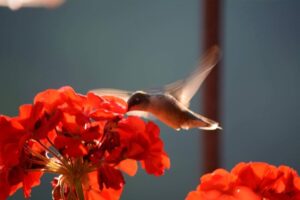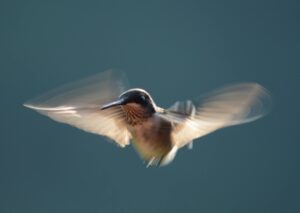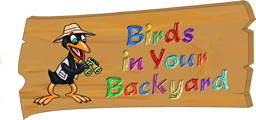Hi everyone! It’s time for another blog. Have you been noticing any new bird behaviours since
spring has arrived? The birds in my backyard have become much louder and I see them in pairs
much more frequently. Sometimes I can hear the birds arguing out in the cedar trees. They are
finding mates and scouting the best locations for their nests. Birds who have recently arrived,
whether from their migration north or just in search of a place to nest, are all competing for
their resources. The great big roosting tree that the crows were in over the winter is now
empty and my suet feeder is almost always occupied by a starling or two.
Last week we talked about how any one species has a great impact on another and learned that this ecological relationship is vital to the survival and well-being of every living thing involved. Have you been able to spot any vultures in the sky? Soon there will be a much smaller bird to keep an eye out for.

Photo credit: Gwen Card
What is the smallest species of bird you can think of? Often green or
brownish with red markings, the hummingbird is the smallest species of bird in Canada. In
Southwestern Ontario, the Ruby-throated Hummingbird is the only species found, although
there are five different species throughout Canada. Last summer when I was reading outside, I
heard a whirring sound by my ear and felt my hair rustle in a breeze. When I looked up, it was a
hummingbird! The hummingbird was floating around my head as if it were observing me. I
watched it for a moment and saw that it had been attracted to the Passionflower vine on my
deck. The purple blooms attracted the hummingbird to its nectar and the hummingbird
returned many times over the summer to feed. I had never had such a close encounter with a
bird so small. It was magical. This year, I am growing Passionflowers from seed to try and
attract more hummingbirds.
As you know, we have been following the northward migration of different bird species this
spring. Soon the Ruby-throated Hummingbird will arrive in Ontario. With the help of technology
connecting citizen scientists throughout North America, we can follow their migration on this
interactive map! https://www.hummingbirdcentral.com/hummingbird-migration-spring-2021-map.htm
Here you will see that the Ruby-throated Hummingbirds are fast approaching and will likely
arrive in early May. There are many ways that you can attract hummingbirds to your backyard.
First, you can plant native species of plants that are a favourite food of hummingbirds. I chose
to plant Butterfly Weed and Red Trumpet Honeysuckle. The honeysuckle grows quite quickly
and blooms early in the season. Additionally, the red colour and shape of the blooms are highly
attractive to hummingbirds. Butterfly Weed blooms later in the season and for a long time.
Hummingbirds are attracted to bright colours and require a huge amount of nectar and insects
daily to maintain their health. They consume about half of their body weight each day to
support their high metabolism and speedy wings.
The next thing we can to do attract hummingbirds: once our flowers are in place and there are
shrubs and trees for shelter, is to eliminate use of pesticides and insecticides in our yard.
Weeds and insects are part of the ecological balance in our yards. Killing off weeds and insects with chemicals is detrimental to birds because they themselves consume the nectar and insects we wish to see gone.

Photo credit: Gwen Card
Hummingbirds consume both insects and their eggs, as do many other
bird species, which means having hummingbirds in the yard reduces insects without our
intervention. Hummingbirds also have a unique relationship with spiders. They use the webs
created by spiders to build their nests! The sticky silk of the spider’s web is the perfect material to strengthen their tiny nest. Sometimes hummingbirds have been known to eat insects that have become trapped in a spider’s web before the spider can even eat them!

Photo credit: Gwen Card
Finally, a hummingbird feeder can be a great way to attract the little birds to your backyard.
These unique-looking feeders hold a sweet mixture of 1 cup white sugar and 4 cups boiled water, do not add food colouring. Keep in mind that the sweet liquid in the feeder can attract bacteria which is harmful to the birds. Keep your feeders nice and clean by washing them each time they are filled and choosing a shady location to hang them, but of course the need to maintain cleanliness is true of all feeders.
Do you think you will plant any native species in your backyard to attract some hummingbirds? I hope you do! I can’t wait for my seeds to begin sprouting and to watch the birds find their new food source. Until next time, happy birding!


Recent Comments